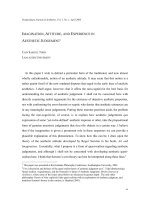SELECTED AND EDITED WITH INTRODUCTIONS, ETC. pptx
Bạn đang xem bản rút gọn của tài liệu. Xem và tải ngay bản đầy đủ của tài liệu tại đây (4.1 MB, 161 trang )
SEEING EUROPE
WITH FAMOUS
AUTHORS
SELECTED AND EDITED
WITH
INTRODUCTIONS, ETC.
BY
FRANCIS W. HALSEY
Editor of "Great Epochs in American History"
Associate Editor of "The Worlds Famous Orations"
and of "The Best of the World's Classics," etc.
IN TEN
VOLUMES
ILLUSTRATED
Vol. VII
ITALY, SICILY, AND GREECE
Part One
FUNK & WAGNALLS COMPANY
NEW YORK AND LONDON
COPYRIGHT, 1914, BY
[Printed in the United States of America]
INTRODUCTION TO VOLUMES VII AND VIII
Italy, Sicily and Greece
Tourists in great numbers now go to Italy by steamers that have Naples and Genoa for
ports. By the fast Channel steamers, however, touching at Cherbourg and Havre, one
may make the trip in less time (rail journey included). In going to Rome, four days
could thus be saved; but the expense will be greater—perhaps forty per cent.
"and now, fair Italy!
Thou art the garden of the world, the home
Of all Art yields, and Nature can decree;
Even in thy desert, what is like to thee?
Thy very weeds are beautiful, thy waste
More rich than other climes' fertility;
Thy wreck a glory, and thy ruin graced
With an immaculate charm which can not be defaced."
At least four civilizations, and probably five, have dominated Italy; together they
cover a period of more than 3,000 years—Pelasgian, Etruscan, Greek, Roman, Italian.
Of these the Pelasgian is, in the main, legendary. Next came the Etruscan. How old
that civilization is no man knows, but its beginnings date from at least 1000 B.C.—
that is, earlier than Homer's writings, and earlier by nearly three centuries than the
wall built by Romulus around Rome. The Etruscan state was a federation of twelve
cities, embracing a large part of central and northern Italy—from near Naples as far
north perhaps as Milan and the great Lombard plain. Etruscans thus dominated the
largest, and certainly the fairest, parts of Italy. Before Rome was founded, the
Etruscan cities were populous and opulent commonwealths. Together they formed one
of the great naval powers of the Mediterranean. Of their civilization, we have
abundant knowledge from architectural remains, and, from thousands of inscriptions
still extant. Cortona was one of their oldest towns. "Ere Troy itself arose, Cortona
was."
After the Etruscans, came Greeks, who made flourishing settlements in southern Italy,
the chief of which was Paestum, founded not later than 600 B.C. Stupendous ruins
survive at Paestum; few more interesting ones have come down to us from the world
of ancient Hellas. The oldest dates from about 570 B.C. Here was once the most
fertile and beautiful part of Italy, celebrated for its flowers so that Virgil praised them.
It is now a lonely and forsaken land, forbidding and malarious. Once thickly
populated, it has become scarcely more than a haunt of buffalos and peasants, who
wander indifferent among these colossal remains of a vanished race. These, however,
are not the civilizations that do most attract tourists to Italy, but the remains found
there of ancient Rome. Of that empire all modern men are heirs—heirs of her
marvelous political structure, of her social and industrial laws.
Last of these five civilizations is the Italian, the beginnings of which date from
Theodoric the Goth, who in the fifth century set up a kingdom independent of Rome;
but Gothic rule was of short life, and then came the Lombards, who for two hundred
years were dominant in northern and central parts, or until Charlemagne grasped their
tottering kingdom and put on their famous Iron Crown. In the south Charlemagne's
empire never flourished. That part of Italy was for centuries the prey of Saracens,
Magyars and Scandinavians. From these events emerged modern Italy—the rise of her
vigorous republics, Pisa, Genoa, Florence, Venice; the dawn, meridian splendor and
decline of her great schools of sculpture, painting and architecture, the power and
beauty of which have held the world in subjection; her literature, to which also the
world has become a willing captive; her splendid municipal spirit; a Church, whose
influence has circled the globe, and in which historians, in a spiritual sense, have seen
a survival of Imperial Rome. But here are tales that every schoolboy hears.
Sicily is reached in a night by steamer from Naples to Palermo, or the tourist may go
by train from Naples to Reggio, and thence by ferry across the strait to Messina. Its
earliest people were contemporaries of the Etruscans. Phœnicians also made
settlements there, as they did in many parts of the Mediterranean, but these were
purely commercial enterprises. Real civilization in Sicily dates from neither of those
races, but from Dorian and Ionic Greeks, who came perhaps as early as the founding
of Rome—that is, in the seventh or eighth century B.C. The great cities of the Sicilian
Greeks were Syracuse, Segesta and Girgenti, where still survive colossal remains of
their genius. In military and political senses, the island for 3,000 years has been
overrun, plundered and torn asunder by every race known to Mediterranean waters.
Beside those already named, are Carthaginians under Hannibal, Vandals under
Genseric, Goths under Theodoric, Byzantines under Belisarius, Saracens from Asia
Minor, Normans under Robert Guiscard, German emperors of the thirteenth century,
French Angevine princes (in whose time came the Sicilian Vespers), Spaniards of the
house of Aragon, French under Napoleon, Austrians of the nineteenth century, and
then—that glorious day when Garibaldi transferred it to the victorious Sardinian king.
The tourist who seeks Greece from northern Europe may go from Trieste by steamer
along the Dalmatian coast (in itself a trip of fine surprizes), to Cattaro and Corfu,
transferring to another steamer for the Piræus, the port of Athens; or from Italy by
steamer direct from Brindisi, the ancient Brundusium, whence sailed all Roman
expeditions to the East, and where in retirement once dwelt Cicero. No writer has
known where to date the beginnings of civilization in Greece, but with Mycenæ,
Tiryns, and the Minoan palace of Crete laid bare, antiquarians have pointed the way
to dates far older than anything before recorded. The palace of Minos is ancient
enough to make the Homeric age seem modern. With the Dorian invasion of Greece
about 1000 B.C., begins that Greek civilization of which we have so much authentic
knowledge. Dorian influence was confined largely to Sparta, but it spread to many
Greek colonies in the central Mediterranean and in the Levant. It became a powerful
influence, alike in art, in domestic life, and in political supremacy. One of its noblest
achievements was its help in keeping out the Persian, and another in supplanting in the
Mediterranean the commercial rule of Phœnicians. Attica and Sparta became world-
famous cities, with stupendous achievements in every domain of human art and
human efficiency. The colossal debt all Europe and all America owe them, is known
to everyone who has ever been to school.
F. W. H.
CONTENTS OF VOLUME VII
Italy, Sicily, and Greece—Part One
INTRODUCTION TO VOLS. VII AND VIII—By the Editor.
I—ROME
PAGE
FIRST DAYS IN THE ETERNAL CITY—By Johann
Wolfgang von Goethe
1
THE ANTIQUITIES—By Joseph Addison
10
THE PALACE OF THE CÆSARS—By Rodolfo
Lanciani
17
THE COLISEUM—By George S. Hillard
24
THE PANTHEON—By George S. Hillard
29
HADRIAN'S TOMB—By Rodolfo Lanciani
32
TRAJAN'S FORUM—By Francis Wey
35
THE BATHS OF CARACALLA—By Hippolyte
Adolphe Taine
37
THE AQUEDUCT BUILDERS—By Rodolfo Lanciani
41
THE QUARRIES AND BRICKS OF THE ANCIENT
City—By Rodolfo Lanciani
45
PALM SUNDAY IN ST. PETER—By Grace
Greenwood (Mrs. Lippincott)
53
THE ELECTION OF A POPE—By Cardinal Wiseman
55
AN AUDIENCE WITH PIUS X.—By Mary Emogene
Hazeltine
59
THE ASCENT OF THE DOME OF ST. PETER'S—By
George S. Hillard
64
SANTA MARIA MAGGIORE—By Hippolyte
Adolphe Taine
67
CATACOMBS AND CRYPTS—By Charles Dickens
69
THE CEMETERY OF THE CAPUCHINS—By Nathaniel
Hawthorne
73
THE BURIAL PLACE OF KEATS AND SHELLEY—By
Nathaniel Parker Willis
75
EXCURSIONS NEAR ROME—By Charles Dickens
78
II—FLORENCE
THE APPROACH BY CARRIAGE ROAD—By Nathaniel
Hawthorne
83
THE OLD PALACE AND THE LOGGIA—By Theophile
Gautier
86
THE ORIGINS OF THE CITY—By Grant Allen
92
THE CATHEDRAL—By Hippolyte Adolphe
Taine
96
THE ASCENT OF THE DOME OF BRUNELLESCHI—By
Mr. and Mrs. Edwin H. Blashfield
102
ARNOLFO, GIOTTO AND BRUNELLESCHI—By
Mrs. Oliphant
106
GHIBERTI'S GATES—By Charles Yriarte
116
THE PONTE VECCHIO By Charles Yriarte
119
SANTA CROCE—By Charles Yriarte
121
THE UFFIZI GALLERY—By Hippolyte Adolphe
Taine
125
FLORENCE EIGHTY YEARS AGO—By William
Cullen Bryant
131
III—VENICE
THE APPROACH FROM THE SEA—By Charles
Yriarte
138
THE APPROACH BY TRAIN—By the Editor
140
A TOUR OF THE GRAND CANAL—By Theophile
Gautier
143
ST. MARK'S CHURCH—By John Ruskin
148
HOW THE OLD CAMPANILE WAS BUILT—By
Horatio F. Brown
155
HOW THE CAMPANILE FELL—By Horatio F.
Brown
161
THE PALACE OF THE DOGES—By John Ruskin
163
THE LAGOONS—By Horatio F. Brown
174
THE DECLINE AMID SPLENDOR By Hippolyte
Adolphe Taine
177
THE DOVES OF ST. MARK'S—By Horatio F.
Brown
183
TORCELLO, THE MOTHER CITY—By John Ruskin
186
CADORE, TITIAN'S BIRTHPLACE—By Amelia B.
Edwards
189
LIST OF ILLUSTRATIONS
VOLUME VII
FRONTISPIECE
THE COLISEUM AND THE ARCH OF TITUS
PRECEDING PAGE
1
THE PANTHEON, ROME
ROME: THE TIBER, CASTLE OF ST. ANGELO, AND DOME OF ST.
PETER'S
ROME: RUINS OF THE PALACE OF THE CÆSARS
ROME: THE SAN SEBASTIAN GATE
THE TOMB OF METELLA ON THE APPIAN WAY
THE TARPEIAN ROCK IN ROME
INTERIOR OF THE COLISEUM
THE COLISEUM, ROME
ST. PETER'S, ROME
ROME: INTERIOR OF ST. PETER'S
ROME: INTERIOR OF SANTA MARIA MAGGIORE
THE CATHEDRAL, FLORENCE
FOLLOWING PAGE
96
FLORENCE: BRIDGE ACROSS THE ARNO
FLORENCE: THE OLD PALACE
FLORENCE: THE LOGGIA DI LANZI
FLORENCE: CLOISTER OF SANTA MARIA NOVELLA
FLORENCE: CLOISTER OF SAN MARCO
FLORENCE: THE PITTI PALACE
FLORENCE: HOUSE OF DANTE
FRONT OF ST. MARK'S, VENICE
INTERIOR OF ST. MARK'S, VENICE
THE DUCAL PALACE, VENICE
VENICE: PIAZZA OF ST. MARK'S, DUCAL PALACE ON THE LEFT
VIEW OF VENICE FROM THE CAMPANILE
THE PANTHEON OF ROME
Illustration: Courtesy John C. Winston Co.
THE TIBER, CASTLE OF ST. ANGELO, AND DOME OF ST. PETER'S
Illustration: Courtesy John C. Winston Co.
RUINS OF THE PALACE OF THE CÆSARS
THE SAN SEBASTIAN GATE OF ROME
THE TOMB OF METELLA ON THE APPIAN WAY
Courtesy John C. Winston Co.
THE TARPEIAN ROCK IN ROME
Courtesy John C. Winston Co.
INTERIOR OF THE COLISEUM
THE COLISEUM
ST. PETER'S, ROME
Courtesy John C. Winston Co.
ROME: INTERIOR OF ST. PETER'S
INTERIOR OF SANTA MARIA MAGGIORE
THE CATHEDRAL OF FLORENCE
I
ROME
FIRST DAYS IN THE ETERNAL CITY
[1]
BY JOHANN WOLFGANG VON GOETHE
At last I am arrived in this great capital of the world. If fifteen years ago I could have
seen it in good company, with a well-informed guide, I should have thought myself
very fortunate. But as it was to be that I should thus see it alone, and with my own
eyes, it is well that this joy has fallen to my lot so late in life.
Over the mountains of the Tyrol I have as good as flown. Verona, Vicenza, Padua,
and Venice I have carefully looked at; hastily glanced at Ferrara, Cento, Bologna, and
scarcely seen Florence at all. My anxiety to reach Rome was so great, and it so grew
with me every moment, that to think of stopping anywhere was quite out of the
question; even in Florence, I only stayed three hours. Now I am here at my ease, and
as it would seem, shall be tranquilized for my whole life; for we may almost say that a
new life begins when a man once sees with his own eyes all that before he has but
partially heard or read of.
All the dreams of my youth I now behold realized before me; the subjects of the first
engravings I ever remembered seeing (several views of Rome were hung up in an
anteroom of my father's house) stand bodily before my sight, and all that I had long
been acquainted with, through paintings or drawings, engravings, or wood-cuts,
plaster-casts, and cork models are here collectively presented to my eye. Wherever I
go I find some old acquaintance in this new world; it is all just as I had thought it, and
yet all is new; and just the same might I remark of my own observations and my own
ideas. I have not gained any new thoughts, but the older ones have become so defined,
so vivid, and so coherent, that they may almost pass for new ones
I have now been here seven days, and by degrees have formed in my mind a general
idea of the city. We go diligently backward and forward. While I am thus making
myself acquainted with the plan of old and new Rome, viewing the ruins and the
buildings, visiting this and that villa, the grandest and most remarkable objects are
slowly and leisurely contemplated. I do but keep my eyes open and see, and then go
and come again, for it is only in Rome one can duly prepare oneself for Rome. It must,
in truth, be confessed, that it is a sad and melancholy business to prick and track out
ancient Rome in new Rome; however, it must be done, and we may hope at least for
an incalculable gratification. We meet with traces both of majesty and of ruin, which
alike surpass all conception; what the barbarians spared, the builders of new Rome
made havoc of
When one thus beholds an object two thousand years old and more, but so manifoldly
and thoroughly altered by the changes of time, but, sees nevertheless, the same soil,
the same mountains, and often indeed the same walls and columns, one becomes, as it
were, a contemporary of the great counsels of Fortune, and thus it becomes difficult
for the observer to trace from the beginning Rome following Rome, and not only new
Rome succeeding to the old, but also the several epochs of both old and new in
succession. I endeavor, first of all, to grope my way alone through the obscurer parts,
for this is the only plan by which one can hope fully and completely to perfect by the
excellent introductory works which have been written from the fifteenth century to the
present day. The first artists and scholars have occupied their whole lives with these
objects.
And this vastness has a strangely tranquilizing effect upon you in Rome, while you
pass from place to place, in order to visit the most remarkable objects. In other places
one has to search for what is important; here one is opprest, and borne down with
numberless phenomena. Wherever one goes and casts a look around, the eye is at once
struck with some landscape—forms of every kind and style; palaces and ruins,
gardens and statuary, distant views of villas, cottages and stables, triumphal arches
and columns, often crowding so close together, that they might all be sketched on a
single sheet of paper. He ought to have a hundred hands to write, for what can a single
pen do here; and, besides, by the evening one is quite weary and exhausted with the
day's seeing and admiring.
My strange, and perhaps whimsical, incognito proves useful to me in many ways that I
never should have thought of. As every one thinks himself in duty bound to ignore
who I am, and consequently never ventures to speak to me of myself and my
works,
[2]
they have no alternative left them but to speak of themselves, or of the
matters in which they are most interested, and in this way I become circumstantially
informed of the occupations of each, and of everything remarkable that is either taken
in hand or produced. Hofrath Reiffenstein good-naturedly humors this whim of mine;
as, however, for special reasons, he could not bear the name which I had assumed, he
immediately made a Baron of me, and I am now called the "Baron gegen Rondanini
über" (the Baron who lives opposite to the Palace Rondanini). This designation is
sufficiently precise, especially as the Italians are accustomed to speak of people either
by their Christian names, or else by some nickname. Enough; I have gained my object;
and I escape the dreadful annoyance of having to give to everybody an account of
myself and my works
In Rome, the Rotunda,
[3]
both by its exterior and interior, has moved me to offer a
willing homage to its magnificence. In St. Peter's I learned to understand how art, no
less than nature, annihilates the artificial measures and dimensions of man. And in the
same way the Apollo Belvidere also has again drawn me out of reality. For as even the
most correct engravings furnish no adequate idea of these buildings, so the case is the
same with respect to the marble original of this statue, as compared with the plaster
models of it, which, however, I formerly used to look upon as beautiful.
Here I am now living with a calmness and tranquility to which I have for a long while
been a stranger. My practise to see and take all things as they are, my fidelity in letting
the eye be my light, my perfect renunciation of all pretension, have again come to my
aid, and make me calmly, but most intensely, happy. Every day has its fresh
remarkable object—every day its new grand unequaled paintings, and a whole which
a man may long think of, and dream of, but which with all his power of imagination
he can never reach.
Yesterday I was at the Pyramid of Cestius, and in the evening on the Palatine, on the
top of which are the ruins of the palace of the Cæsars, which stand there like walls of
rock. Of all this, however, no idea can be conveyed! In truth, there is nothing little
here; altho, indeed, occasionally something to find fault with—something more or less
absurd in taste, and yet even this partakes of the universal grandeur of all around
Yesterday I visited the nymph Egeria, and then the Hippodrome of Caracalla, the
ruined tombs along the Via Appia, and the tomb of Metella, which is the first to give
one a true idea of what solid masonry really is. These men worked for eternity—all
causes of decay were calculated, except the rage of the spoiler, which nothing can
resist. The remains of the principal aqueduct are highly venerable. How beautiful and
grand a design, to supply a whole people with water by so vast a structure! In the
evening we came upon the Coliseum, when it was already twilight. When one looks at
it, all else seems little; the edifice is so vast, that one can not hold the image of it in
one's soul—in memory we think it smaller, and then return to it again to find it every
time greater than before.
We entered the Sistine Chapel, which we found bright and cheerful, and with a good
light for the pictures. "The Last Judgment" divided our admiration with the paintings
on the roof by Michael Angelo. I could only see and wonder. The mental confidence
and boldness of the master, and his grandeur of conception, are beyond all expression.
After we had looked at all of them over and over again, we left this sacred building,
and went to St. Peter's, which received from the bright heavens the loveliest light
possible, and every part of it was clearly lit up. As men willing to be pleased, we were
delighted with its vastness and splendor, and did not allow an over-nice or
hypercritical taste to mar our pleasure. We supprest every harsher judgment; we
enjoyed the enjoyable.
Lastly we ascended the roof of the church, where one finds in little the plan, of a well-
built city. Houses and magazines, springs (in appearance at least), churches, and a
great temple all in the air, and beautiful walks between. We mounted the dome, and
saw glistening before us the regions of the Apennines, Soracte, and toward Tivoli the
volcanic hills. Frascati, Castelgandolfo, and the plains, and beyond all the sea. Close
at our feet lay the whole city of Rome in its length and breadth, with its mountain
palaces, domes, etc. Not a breath of air was moving, and in the upper dome it was (as
they say) like being in a hot-house. When we had looked enough at these things, we
went down, and they opened for us the doors in the cornices of the dome, the
tympanum, and the nave. There is a passage all round, and from above you can take a
view of the whole church, and of its several parts. As we stood on the cornices of the
tympanum, we saw beneath us the pope passing to his mid-day devotions. Nothing,
therefore, was wanting to make our view of St. Peter's perfect. We at last descended to
the piazza, and took in a neighboring hotel a cheerful but frugal meal, and then set off
for St. Cecilia's.
It would take many words to describe the decorations of this church, which was
crammed full of people; not a stone of the edifice was to be seen. The pillars were
covered with red velvet wound round with gold lace; the capitals were overlaid with
embroidered velvet, so as to retain somewhat of the appearance of capitals, and all the
cornices and pillars were in like manner covered with hangings. All the entablatures of
the walls were also covered with life-like paintings, so that the whole church seemed
to be laid out in mosaic. Around the church, and on the high altar more than two
hundred wax tapers were burning. It looked like a wall of lights, and the whole nave
was perfectly lit up. The aisles and side altars were equally adorned and illuminated.
Right opposite the high altar, and under the organ, two scaffolds were erected, which
also were covered with velvet, on one of which were placed the singers, and on the
other the instruments, which kept up one unbroken strain of music
And yet these glorious objects are even still like new acquaintances to me. One has
not yet lived with them, nor got familiar with their peculiarities. Some of them attract
us with irresistible power, so that for a time one feels indifferent, if not unjust, toward
all others. Thus, for instance, the Pantheon, the Apollo Belvedere, some colossal
heads, and very recently the Sistine Chapel, have by turns so won my whole heart, that
I scarcely saw any thing besides them. But, in truth, can man, little as man always is,
and accustomed to littleness, ever make himself equal to all that here surrounds him of
the noble, the vast, and the refined? Even tho he should in any degree adapt himself to
it, then how vast is the multitude of objects that immediately press upon him from all
sides, and meet him at every turn, of which each demands for itself the tribute of his
whole attention. How is one to get out of the difficulty? No other way assuredly than
by patiently allowing it to work, becoming industrious, and attending the while to all
that others have accomplished for our benefit.
Of the beauty of a walk through Rome by moonlight it is impossible to form a
conception, without having witnessed it. All single objects are swallowed up by the
great masses of light and shade, and nothing but grand and general outlines present
themselves to the eye. For three several days we have enjoyed to the full the brightest
and most glorious of nights. Peculiarly beautiful at such a time is the Coliseum. At
night it is always closed; a hermit dwells in a little shrine within its range, and beggars
of all kinds nestle beneath its crumbling arches; the latter had lit a fire on the arena,
and a gentle wind bore down the smoke to the ground, so that the lower portion of the
ruins was quite hid by it, while above the vast walls stood out in deeper darkness
before the eye. As we stopt at the gate to contemplate the scene through the iron
gratings, the moon shone brightly in the heavens above. Presently the smoke found its
way up the sides, and through every chink and opening, while the moon lit it up like a
cloud. The sight was exceedingly glorious. In such a light one ought also to see the
Pantheon, the Capitol, the Portico of St. Peter's, and the other grand streets and
squares—and thus sun and moon, like the human mind, have quite a different work to
do here from elsewhere, where the vastest and yet the most elegant of masses present
themselves to their rays.
THE ANTIQUITIES OF THE CITY
[4]
BY JOSEPH ADDISON
There are in Rome two sets of antiquities, the Christian, and the heathen. The former,
tho of a fresher date, are so embroiled with fable and legend, that one receives but
little satisfaction from searching into them. The other give a great deal of pleasure to
such as have met with them before in ancient authors; for a man who is in Rome can
scarce see an object that does not call to mind a piece of a Latin poet or historian.
Among the remains of old Rome, the grandeur of the commonwealth shows itself
chiefly in works that were either necessary or convenient, such as temples, highways,
aqueducts, walls, and bridges of the city. On the contrary, the magnificence of Rome
under the emperors is seen principally in such works as were rather for ostentation or
luxury, than any real usefulness or necessity, as in baths, amphitheaters, circuses,
obelisks, triumphal pillars, arches, and mausoleums; for what they added to the
aqueducts was rather to supply their baths and naumachias, and to embellish the city
with fountains, than out of any real necessity there was for them
No part of the antiquities of Rome pleased me so much as the ancient statues, of
which there is still an incredible variety. The workmanship is often the most exquisite
of anything in its kind. A man would wonder how it were possible for so much life to
enter into marble, as may be discovered in some of the best of them; and even in the
meanest, one has the satisfaction of seeing the faces, postures, airs, and dress of those
that have lived so many ages before us. There is a strange resemblance between the
figures of the several heathen deities, and the descriptions that the Latin poets have
given us of them; but as the first may be looked upon as the ancienter of the two, I
question not but the Roman poets were the copiers of the Greek statuaries. Tho on
other occasions we often find the statuaries took their subjects from the poets. The
Laocöon is too known an instance among many others that are to be met with at
Rome.
I could not forbear taking particular notice of the several musical instruments that are
to be seen in the hands of the Apollos, muses, fauns, satyrs, bacchanals, and
shepherds, which might certainly give a great light to the dispute for preference
between the ancient and modern music. It would, perhaps, be no impertinent design to
take off all their models in wood, which might not only give us some notion of the
ancient music, but help us to pleasanter instruments than are now in use. By the
appearance they make in marble, there is not one string-instrument that seems
comparable to our violins, for they are all played on either by the bare fingers, or the
plectrum, so that they were incapable of adding any length to their notes, or of varying
them by those insensible swellings, and wearings away of sound upon the same string,









